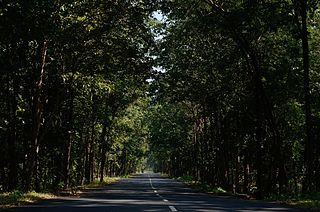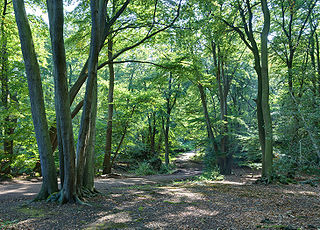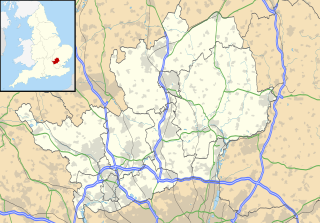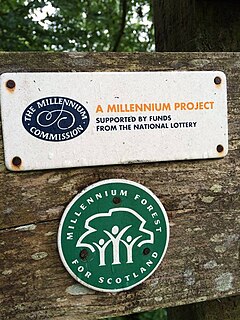
A forest is a large area dominated by trees. Hundreds of more precise definitions of forest are used throughout the world, incorporating factors such as tree density, tree height, land use, legal standing and ecological function. According to the widely used Food and Agriculture Organization definition, forests covered 4 billion hectares (9.9×109 acres) (15 million square miles) or approximately 30 percent of the world's land area in 2006.

Forestry is the science and craft of creating, managing, using, conserving, and repairing forests, woodlands, and associated resources for human and environmental benefits. Forestry is practiced in plantations and natural stands. The science of forestry has elements that belong to the biological, physical, social, political and managerial sciences.

The Woodland Trust is the largest woodland conservation charity in the United Kingdom concerned with the creation, protection, and restoration of native woodland heritage. It has planted over 43 million trees since 1972.

Urban forestry is the care and management of single trees and tree populations in urban settings for the purpose of improving the urban environment. Urban forestry involves both planning and management, including the programming of care and maintenance operations of the urban forest. Urban forestry advocates the role of trees as a critical part of the urban infrastructure. Urban foresters plant and maintain trees, support appropriate tree and forest preservation, conduct research and promote the many benefits trees provide. Urban forestry is practiced by municipal and commercial arborists, municipal and utility foresters, environmental policymakers, city planners, consultants, educators, researchers and community activists.

In the United Kingdom, an ancient woodland is a woodland that has existed continuously since 1600 or before in England, Wales and Northern Ireland. Planting of woodland was uncommon before those dates, so a wood present in 1600 is likely to have developed naturally.

Afforestation is the establishment of a forest or stand of trees (forestation) in an area where there was no previous tree cover.
The Midland Reafforesting Association (MRA) was an early environmental organisation concerned with facilitating the planting of trees (reforestation) on land degraded by previous industrial activity. Such work was motivated by the aims of promoting landscape enhancement, improving the local environment and achieving the restoration of land to more productive land uses.

Social forestry is the management and protection of forests and afforestation of barren and deforested lands with the purpose of helping environmental, social and rural development. The term social forestry was first used in 1976 by The National Commission on Agriculture, when the government of India aimed to reduce pressure on forests by planting trees on all unused and fallow lands. It was intended as a democratic approach to forest conservation and usage, maximizing land utilization for multiple purposes.
Private landowner assistance program (PLAP) is a class of government assistance program available throughout the U.S. for landowners interested in maintaining, developing, improving and protecting wildlife on their property. Each state provides various programs that assist landowners in agriculture, forestry and conserving wildlife habitat. This helps landowners in the practice of good land stewardship and provides multiple benefits to the environment. Some states offer technical assistance which includes:

Canada's boreal forest is a vast region comprising about one third of the circumpolar boreal forest that rings the Northern Hemisphere, mostly north of the 50th parallel. Other countries with boreal forest, include Russia, which contains the majority, the United States in its northern most state of Alaska, and the Scandinavian or Northern European countries. In Europe, the entire boreal forest is referred to as taiga, not just the northern fringe where it thins out near the tree line. The boreal region in Canada covers almost 60% of the country's land area. The Canadian boreal region spans the landscape from the most easterly part of the province of Newfoundland and Labrador to the border between the far northern Yukon and Alaska. The area is dominated by coniferous forests, particularly spruce, interspersed with vast wetlands, mostly bogs and fens. The boreal region of Canada includes eight ecozones. While the biodiversity of regions varies, each ecozone has a characteristic native flora and fauna.

The United Kingdom, being in the British Isles, is ideal for tree growth, thanks to its mild winters, plentiful rainfall, fertile soil and hill-sheltered topography. Growth rates for broadleaved (hardwood) trees exceed those of mainland Europe, while conifer (softwood) growth rates are three times those of Sweden and five times those of Finland. In the absence of people, much of Great Britain would be covered with mature oaks, except for Scotland. Although conditions for forestry are good, trees do face damage threats arising from fungi, parasites and pests.

Heartwood Forest is a planned forest in Hertfordshire, England. The site covers 347 hectares, the largest continuous new native forest in England.
Launched in December 2010, The Big Tree Plant was a Government-sponsored campaign in England to promote the planting of one million trees in neighbourhoods where people live and work. The campaign ran over four years from 2011 to 2015, and was the first such initiative since Plant A Tree In '73.

Dyfnant Forest is a remote forest in northeastern-central Powys, Wales.

Milton Creek Country Park is situated in 128 acres between Milton Regis and Kemsley, on the west bank of Milton Creek in Sittingbourne, Kent, England. This was once called Church Marshes Country Park.
The National Urban Forestry Unit was a British charity established in 1995 to promote urban forestry. It was a charitable organisation which worked to raise awareness of the positive contribution that trees make to the quality of life in towns. It championed urban and community forestry to those tackling such issues as public health, leisure and recreation, land reclamation, built development, heritage and education. It was wound up in 2005.

The Millennium Forest for Scotland project was an initiative created by the Millennium Commission and funded by the National Lottery of the United Kingdom to celebrate the turn of the New Millennium.
The Woodland Trust is leading 70 organizations in the call for a Charter for Trees, Woods and People.
The Northern Forest is a proposed forest in England to encompass five community forests. The aim is to plant 50 million trees by 2032 which would provide a timber industry, leisure opportunities and environmental benefits. Initial funding for the project was granted by the British government in January 2018.